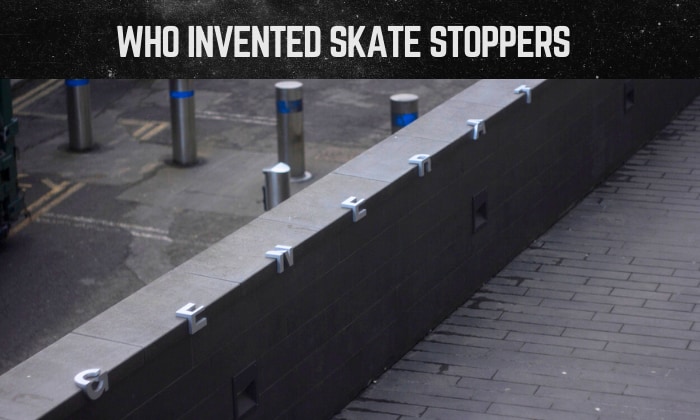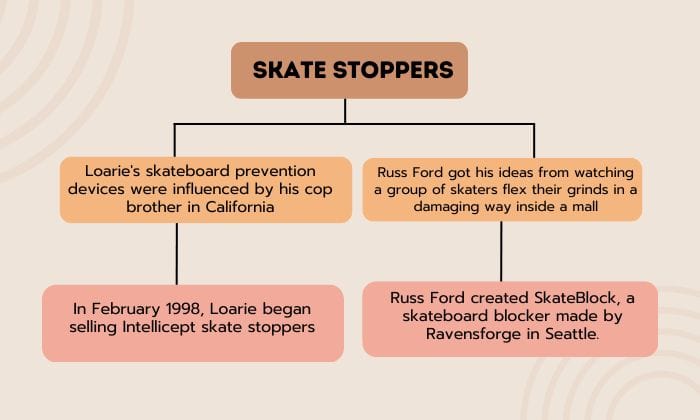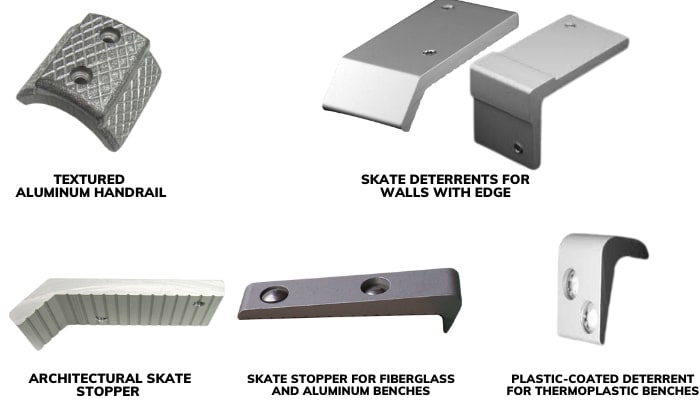Skateboarding allows individuals to have fun and exercise under the sun. And even without a skatepark, skaters still find a way to perform their routine on street fixtures like ledges and concrete boxes.
Unfortunately, not all of these obstacles are in their best condition for skateboarding. Why? Because of skate stoppers. So you could be asking, who invented skate stoppers? The answer is Chris Loarie.
But before hating him, we must know a skate stopper’s invention history and assess if they do more good than bad.
Table of Contents
What Are Skate Stoppers?
Skate stoppers or deterrents are restrictive objects installed on urban skating obstacles like ledges and handrails.
These small fixtures aim to keep properties free from damage, wax buildup, and other marks from skating. They also free the owners of private properties from liabilities caused by injury claims.
And if you’re someone wanting to live in a quiet and peaceful neighborhood, you might want to install these to keep the skaters’ noise off your yard.
Inventor of Skate Stoppers
Perhaps, we now know what was running inside Loarie’s mind when he made his skateboard prevention devices. But his business idea did not just come up out of nowhere.
He first gathered ideas from his cop brother stationed in California, where damaged ledges were common. He then learned about complaints of skateboard-related property assaults in different establishments, including churches.
And that’s when he started selling Intellicept skate stoppers in February 1998. Seeing how much damage skaters leave from grinding on building properties, Loarie has made great numbers selling 5-dollar nylon tabs and rustproof studs.
But given the different styles of skateboard deterrents like stopping clips and those for walls and handrails, are there other creators of these anti-skateboard guards? Yes!
One of them is Russ Ford.
Ford is the proponent of SkateBlock, a deterrent produced by Ravensforge in Seattle. He got his ideas from watching a group of skaters flex their grinds in a damaging way inside a mall.
Despite knowing what inconvenience these items would bring to skaters and their skateboards, Russ Ford insisted on SkateBlocks. Each of these anti skateboard devices costs about $13 to $39 and is made from alloys such as bronze, aluminum, and brass.
Loarie and Ford earned the ire of street riders because of their inventions. But again, letting skaters on to the ledges without deterrents will not stop property damages from recurring.
Types of Skate Stoppers
Chris Loarie also had his fair share of trial and error before coming up with the final design of his skateboard blockers. Here are a few examples of these deterrents in the market today.
1. Textured aluminum handrail – $248.00
2. Skate deterrents for walls with edge
a. 1″ radius – $449.00
b. 1/2″ radius – $449.00
c. 1/8″ – $449.00
3. Skate-stopping clip for chamfered edges – $449.00
4. Architectural skate stopper – $681 (20 pieces)
5. Skate stopper for fiberglass and aluminum benches – $207.00
6. Plastic-coated deterrent for thermoplastic benches – $207.00
Conclusion
Skateboarding does more good than bad to skaters, but not everyone views the activity favorably. One example is store owners, who wanted a way to counter the adverse effects of skateboards on their establishments.
That’s why skate stoppers entered the scene. So, who invented skate stoppers? Chris Loarie and Russ Ford are two great examples.
No, these men meant no harm to skaters. But they also heard what private property and establishment owners complained about. In the end, skateboarding isn’t illegal. It only needs a more appropriate spot where riders can practice without inconveniencing others.

Hi, I am Charles Harris. I opened this site to write as much as I can about my biggest passion – skateboarding!
I started as a clumsy yet passionate rookie 10 years ago to now a still passionate yet much better skateboarder! But I have to tell you, the whole journey has always been fun and rewarding, indeed not without hardship.





